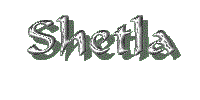Text by Nanna Holt Kjær (February 2000)
Sound Movement
What is sound movement? The well-known English breeder Miss Felicity Rogers of
Riverhill Shelties describes it like this: 'cover the maximum of ground with
the minimum of effort.'
The foundation for sound movement is obviously a sound construction. Good
shoulder angulation and good length of upper arm (a weak spot for many) are
necessary to achieve proper reach in front. Rear movement also requires good
angulation. Straight stifles make it difficult to get the push to propel the
dog forward. Another important factor is the back. The sheltie should be
slightly longer than it is tall, and there should be a slope from croup to
tail. All these factors influence movement according to Miss Rogers.
Physical Condition
The dog's physical condition also influences movement. Even dogs with the
desired construction can move inefficiently if they are in poor physical
condition. And a sheltie of poorer construction can improve its movements
through conditioning of muscles. On top of which it is much healthier for a dog
to be fit - just as it is for us!
The Daily Walk
The daily walk is of great value for the dog; but mostly because it provides
amusement and recreation. The doggy version of watching a good movie or soap,
reading the paper or a good book.
From a fitness perspective the daily walk does not always fulfil the dog's
needs. Only very few owners walk at a speed that fits that of their dog. The
problem is made worse by the dog being on a leash. Most dogs end up pacing
instead of trotting. When pacing, the dog cannot perform long strides and
therefore does not get the opportunity for fully extending with each stride.
Dogs that get most of their exercise on a leash can develop shorter length of
stride simply due to using their muscles incorrectly. Dogs should be given
opportunity to move freely - trotting and galloping - several times a week,
preferably every day.
How to Get Fit
Getting you dog fit is most easily accomplished by cycling. And if you do
agility with your dog, you definitely ought to do this. A fit and well-muscled
dog has much smaller risk of injury.
It is important that the dog runs on a loose leash (or off leash) with free and
unhindered movements. Preferably the surface should be fairly soft. Running
several kilometres on a hard surface puts strain on pads and joints (shock
absorption). I choose gravel paths wherever possible.
Heavy exercising should only be done with mature dogs. For shelties this
usually means at least aged 10 months. If in doubt, it is better to wait some
months rather than risk injury to young and soft ligaments and joints.
Fitness Program
Inspired by the training program in Marie Hansson Hallgren's agility book,
Mera Agility
, I do interval training, i.e. with change of pace. It is important that the dog
gets to run both at the trot and at the gallop. The dog uses different muscle
groups for the two paces. At the trot the long muscles in the back, for
instance, are only sparingly used.
Interval Training:
BEGINNER:
1 km trot
1 km slow/easy gallop
(canter - for horse people)
1 km trot
|
ADVANCED:
1 km trot
1 km slow/easy gallop
1 km trot
1 km slow/easy gallop
1 km trot
|
HARD CORE:
1 km trot
1 km slow/easy gallop
1 km trot
1-2 km hard gallop
1 km trot
1 km slow/easy gallop
1 km trot
|
It is imperative that each exercise session starts at a slow and easy pace to
warm up the body. Each session should likewise end at an easy pace for the body
to wind down and prevent muscle soreness and stiffness developing.
This work out should be done roughly every three days. It is just as important
to give the body a break as it is to work out. The muscles need time to
recover, otherwise the effect is actually opposite to what we are aiming for.
Alternative fitness methods
Swimming can also provide excellent exercise. It is just somewhat seasonal, and
not all shelties like getting wet. But if you have a sheltie that does, then by
all means take advantage of it. You must get your dog really swimming though -
not just splashing about in shallow water. I throw a stick or floating toy
quite a distance out in the water.
When introducing your sheltie to swimming, this is best done in calm waters -
not too many waves or a strong current.
The sheltie's delight in chasing other shelties can also be used. The quick
changes in direction and speed during this play chase, make the dog use many of
its different muscle groups. Just remember the warm-up - the shelties often
forget that in their excitement.
Litterature:
Miss. F.M. Rogers, "Movement in Shelties",
Scottish Shetland Sheepdog Club Handbook 1978
Marie Hansson Hallgren,
Mera Agility.
Jycketryck AB, 1993 (ISBN 91-87652-20-X)
(available in Swedish and Danish only)
|

